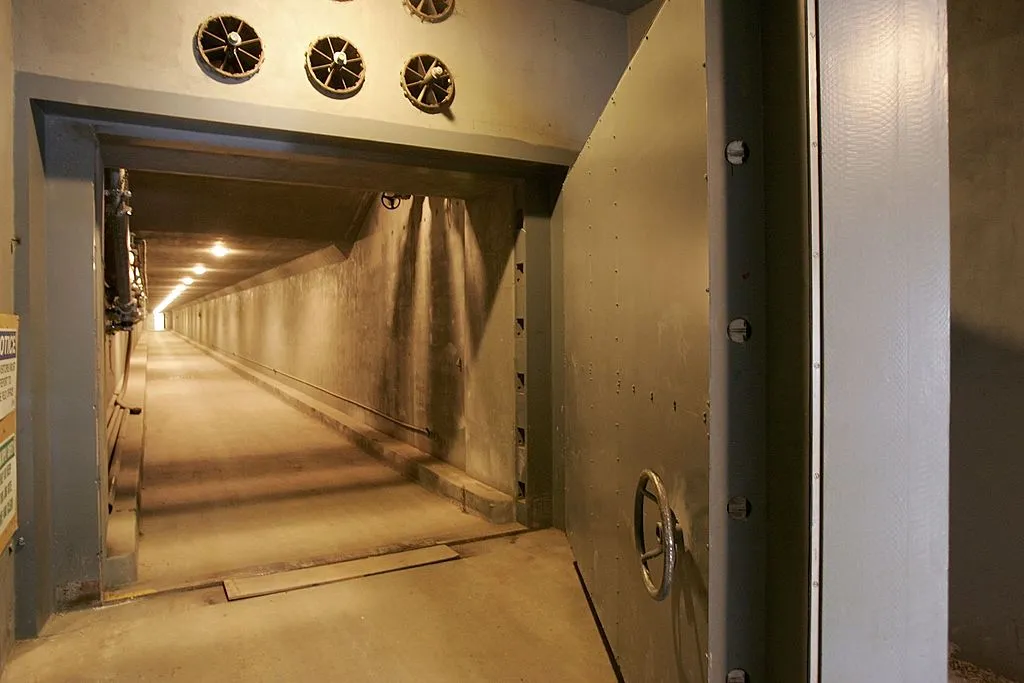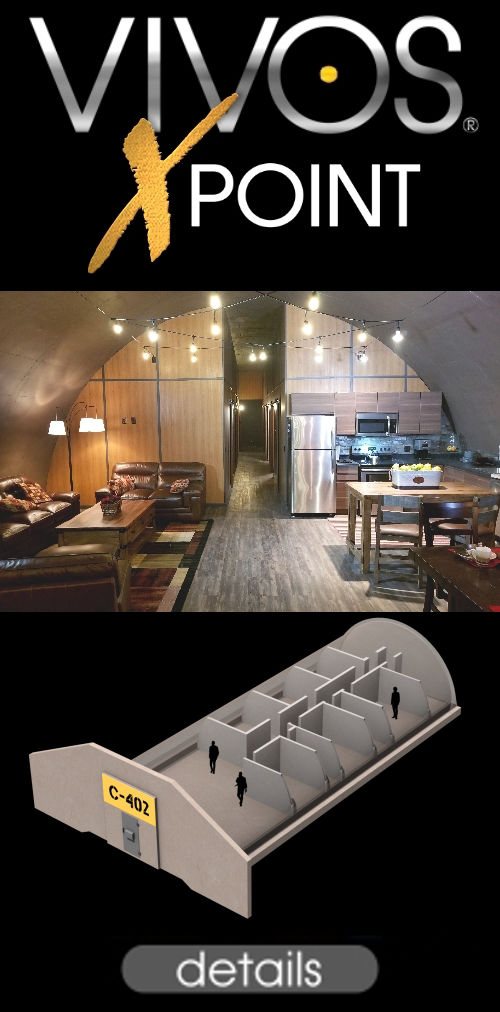
The West Tunnel Blast Door, which weighs 25 tons and serves as an entrance to a former government relocation facility, also known as the bunker, is seen during a media tour at Greenbrier Resort July 14, 2006 in White Sulphur Springs, West Virginia. The bunker, codenamed "Project Greek Island" and planned by the Eisenhower Administration, was a 112,000 square-foot shelter constructed beneath the Greenbrier Resort's West Virginia Wing, to serve as a relocation site for members of the U.S. Congress and associated staff in the event of a nuclear attack on the U.S. soil. The facility was built between 1958 and 1961 and was maintained in a state of operational readiness until the government terminated the lease with the resort in 1995. The bunker will be reopened for public tours on August 20 after a two-year-long renovation. (Photo by Alex Wong/Getty Images) Less
From the inside, the place is reminiscent of a superyacht, only with its nose up, lifted to a vertical position: a steel elevator connects the almost 1,900 square metres of floor space that includes “an organic hydroponic and aquaculture food production system, a general store, an indoor pool and spa, a complete workout facility, a custom theatre (witness the end of times while watching Armageddon from the comfort of your shelter), a custom bar and lounge, a library and a classroom,” – and if that wasn’t enough, there is even a dog park and a rock-climbing wall.
This is the first complex of Survival Condo, situated in a secret location in Kansas, US, in what the company has called “one of the strongest man-made structures ever created; a nuclear hardened bunker with walls as thick as nine and a half feet, made from epoxy hardened concrete that was built back in 1960 to house and protect the Atlas Nuclear Missiles”.




The place is entirely self-sufficient, with its own reserve water tanks of almost 284,000 litres (the average water consumption in South Africa is “233 litres per capita per day compared to a world average of 173”, reported the president of the South African Local Government Association (SALGA) Parks Tau in 2018), air filtration allegedly protecting against nuclear, biological and chemical attacks, and an extra “digital weather station” to monitor potential unwanted natural disasters, from earthquakes to flooding.
Carved into the rock by the American military during the Cold War, it is one of many silos that were built to keep missiles, nukes and military equipment safe – against possible enemy attacks (especially nuclear threats). Today, it has been converted by Larry Hall who, according to The Guardian, is “an ex-government contractor, property developer and doomsday prepper, with a master’s degree in business.”
This 30-hectare above- but mainly below-ground communal and private facility is “capable of withstanding a substantial close range nuclear blast, a direct airliner crash, biological and chemical agents, massive shock waves, earthquakes, electromagnetic pulses, flooding and virtually any armed attack.” In case you wonder, safety is not only offered indoors – in case of an all-hell-break-loose event, “the facility comes with full military grade security that encompasses both lethal and non-lethal measures to ensure the safety of the residents and the facility no matter what the threat,” says the press release.
Survival Condo is not the only facility offering shelter in case of a worldwide meltdown. Somewhere near the Black Hills area of South Dakota lies, under the ground, Vivos xPoint, “the largest (at least, according to its developers) survival community in the world”, 575 bunkers spread over almost 47,000 square metres of land, which is roughly “three-quarters the size of Manhattan”.
Dante Vicino, Executive Director of The Vivos Group, explains that “We typically find locations that the militaries of the world selected as being strategically advantageous for protection. In general, that means well away from major urban centres and in the countryside. Though elevation, weather and state regulations are also important considerations.” Right now, they do not have any plans to build bunkers on the African continent but he adds “that never precludes possibilities for the future. I’d imagine somewhere in South Africa would be ideal if so.”
Scrolling through the images of the showroom shelter presented to future buyers, one could easily be forgiven for thinking you are paging through a catalogue of residential condos in some upmarket suburb, albeit sans next-door neighbours and completely off-grid.
But quickly, images of the Statue of Liberty drowned under water, and the word ‘Prophecies’ popping up in the hamburger menu remind the reader that this is not your usual shopping-for-a-new-home real estate website.
In fact, from the onset, the message is clear: this is about the ‘end times’ residential commitments, a home-away-from-home when the planet and humanity will go wrong. Think “Armageddon, Nibiru/Planet X, a sudden pole shift, future plagues, an EMP blast, a solar kill shot, a super volcanic eruption, major earth changes, killer asteroids and comets, mega tsunami’s (sic)” to all sorts of economic meltdowns. And that doesn’t even include the 2020 pandemic.
But past the heavy “concrete and steel blast door” of the shelter, inside the long nook, the decor resembles a hotel that’s been buried underground; there’s a snug leather sofa with a coffee table, an open-plan kitchen with its microwave, fridge, dishwasher and even green apples, a large dining table, bedrooms with silky assorted duvets and one en-suite bathroom, reclining chairs in the TV room and an attic to store food and essentials for a year.
Vicino says that “This isn’t regular construction! Everything we do is built as traditionally as possible within the radical envelope of the bunker itself. Evidence of this is easily seen on our website as our furnishings and accommodations are as comfortable and recognisable as possible while working with the inherently different nature of the bunker. At the end of the day, a wall is a wall, a bathroom – a bathroom, and a kitchen – a kitchen.”
Interested in buying? You can choose from five different bunker floor plans and have some custom-made interiors made if you’re ready to pay a one-time upfront payment plus an annual “ground rent”. Vicino explains that “a fully enclosed, community bunker (like Indiana or Europa One) may take about a year to fully outfit and make operational.
“For xPoint, the interior buildout can be completed in as little as 100 days! I wouldn’t venture to say this is the only avenue for architecture in the future, but I see this playing a major part as world events (political, manmade and natural) continue to unfold in the way they have, especially in the past year,” he says, adding that since the start of the pandemic, “business has gone up 400%”.
But there’s a trick if you want to buy, at least for options offered by TerraVivos. Although you may have the cash and the desire to purchase your own bunker, it might not be enough to get you a concrete roof over your head.
Based on your application, Vivos selects “the best candidates for each Vivos shelter… We first look for those individuals who may best contribute their skills and expertise to each shelter community, thereby providing the greatest chance of long-term survival of the entire group. Each candidate is reviewed based on a number of criteria.”
The idea is to create a survivalist community of “like-minded” human beings who, thanks to their forward-thinking and the protection offered by shelters they would have purchased while the rest of us walked the world as indefectible optimists, will be able to reshape humanity should it get wiped off the planet by some disaster, war or viral plague.
Vicino explains: “A bunker and the community it pertains to is not an end-user, off-the-shelf product. We are not an Apple Store (that) just runs a credit card and sends you home with your new iPhone. As an applicant, you are buying into, and ultimately participating in, a community of like-minded people. It is incumbent on us as a company, and our integrity to our bunker owners, that we have some level of screening, vetting, and background checking to ensure we are bringing people who are safe and positive for the community they join. This vetting process doesn’t discriminate against race, religion, sex, or occupation. Rather, we look for genuinely good people with solid morals, integrity, and good character who will contribute to the greater community of bunker owners that Vivos has built over the past decade.”


It is important to remember that in the US, under Federal Law, the Fair Housing Act of 1968 and the Fair Housing Amendments Act of 1988 “prohibit discrimination on the basis of the following criteria (called ‘protected categories’): race or color; religion; national origin; familial status or age – and includes families with children under the age of 18 and pregnant women; disability or handicap, or sex”.
On Vivos’ website, the process is explained as, “Once your application is received, a member of the Vivos Selection Team will review it and if they determine you are a worthy candidate, will contact you by email and request to schedule a convenient time that you may privately talk by phone. It is important that you respond to their email in a timely manner and follow-thru on this final step for membership approval.”
And if you wonder what makes for a “worthy” candidate, Vicino says: “Are you a good person? What makes you someone who we wouldn’t want to be without in the event of a catastrophe? What sort of community are you hoping to build within the different TerraVivos shelter sites?
“Wholesome, cooperative, neighborly, caring, and like-minded are all descriptions that come to mind of the communities we build and hope to (build) in the future”. DM/ ML
Read on Wednesday, Part Two of our series ‘Doomsday Architecture’ – Confined spaces, isolation, and faked reality: could you live in ‘The Truman Show’?
And on Thursday, Part Three: My own private bunker

No comments:
Post a Comment